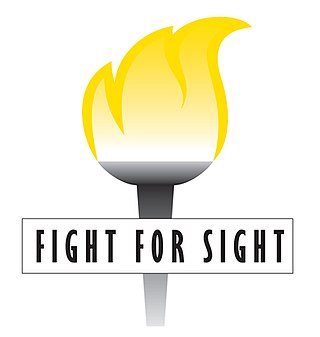Related Research Articles

The Johns Hopkins Bloomberg School of Public Health is the public health graduate school of Johns Hopkins University, a private research university in Baltimore, Maryland. As the second independent, degree-granting institution for research in epidemiology and training in public health, and the largest public health training facility in the United States, the school is ranked first in public health in the U.S. News & World Report rankings and has held that ranking since 1994. The school is ranked second for public health in the world by the Shanghai Rankings.
Neuro-ophthalmology is an academically-oriented subspecialty that merges the fields of neurology and ophthalmology, often dealing with complex systemic diseases that have manifestations in the visual system. Neuro-ophthalmologists initially complete a residency in either neurology or ophthalmology, then do a fellowship in the complementary field. Since diagnostic studies can be normal in patients with significant neuro-ophthalmic disease, a detailed medical history and physical exam is essential, and neuro-ophthalmologists often spend a significant amount of time with their patients.

The Johns Hopkins University School of Medicine (JHUSOM) is the medical school of Johns Hopkins University, a private research university in Baltimore, Maryland. Founded in 1893, the School of Medicine shares a campus with Johns Hopkins Hospital and Johns Hopkins Children's Center, established in 1889.

Alfred (Al) Sommer is a prominent American ophthalmologist and epidemiologist at the Johns Hopkins Bloomberg School of Public Health. His research on vitamin A in the 1970s and 1980s revealed that dosing even mildly vitamin A deficient children with an inexpensive, large dose vitamin A capsule twice a year reduces child mortality by as much as 34 percent. The World Bank and the Copenhagen Consensus list vitamin A supplementation as one of the most cost-effective health interventions in the world.

Fight for Sight is a nonprofit organization in the United States which funds medical research in vision and ophthalmology. It was formed in 1946 as the National Council to Combat Blindness (NCCB), the first non-profit organization in the United States to fund vision research; 2011 marked its 65th anniversary.

Arnall Patz was an American medical doctor and research professor at Johns Hopkins University. In the early 1950s, Patz discovered that oxygen therapy was the cause of an epidemic of blindness among some 10,000 premature babies. Following his discovery, there was a sixty percent reduction in childhood blindness in the United States. He also conducted pioneering research in the 1960s into the use of lasers in the treatment of retinal disorders. He received the Lasker Award in 1956 for his research into the causes and prevention of blindness and the Presidential Medal of Freedom in 2004 for his lifetime of work in the field of ophthalmology.
Elias I. Traboulsi is a physician in the fields of ophthalmic genetics and pediatric ophthalmology.
David Paton is a retired ophthalmologist best known as founder in 1970 of Project Orbis and thereafter as its first Medical Director helping to develop (1970–1982) and then deploy its teaching aircraft for ophthalmologists worldwide, especially in the developing nations. Paton resigned from Orbis in 1987 and focused on other aspects of academic ophthalmology, but in 2011 he returned in a voluntary capacity to assist in fund raising for a new annual appointment, the David Paton Orbis Fellowship in Global Ophthalmology.
Julia A. Haller is an American ophthalmologist who is a Professor and Chair of the Department of Ophthalmology at Sidney Kimmel Medical College at Thomas Jefferson University. She also holds the William Tasman, M.D. Endowed Chair at Wills Eye Hospital in Philadelphia, where she is Ophthalmologist-in-Chief.
Richard D. Semba is an American ophthalmologist, medical researcher and professor. Semba currently is the W. Richard Green Professor of Ophthalmology at the Johns Hopkins School of Medicine, where he leads the Semba laboratory. He is Affiliated Faculty with the Center for a Livable Future at the Johns Hopkins Bloomberg School of Public Health.
Rohit Varma is an Indian-American ophthalmologist and professor of ophthalmology and preventive medicine. In 2014, he was named director of the USC Eye Institute and chairman of the Department of Ophthalmology for Keck School of Medicine of USC. In March 2016, Varma was named the interim dean of the Keck School of Medicine, and in November was named dean. In October 2017, USC announced that he stepped down as dean. In October 2018, Varma became the founding director of the Southern California Eyecare and Vision Research Institute.
Alfred Edward Maumenee, Jr. was an American ophthalmologist who pioneered treatments for retinal diseases, macular degeneration and glaucoma and was a leading surgeon for corneal transplants and cataracts.
John Donald MacIntyre Gass was a Canadian-American ophthalmologist, one of the world's leading specialists on diseases of the retina. He was the first to describe many macular diseases.
Frank Burton Walsh was a Canadian-American ophthalmologist known for his work in neuro-ophthalmology. For most of his career, Walsh worked as a neuro-ophthalmologist at the Wilmer Eye Institute of Johns Hopkins Hospital. Walsh is best known for his textbook Clinical Neuro-Ophthalmology, which contains a compilation of Walsh's case reports and the conclusions he drew from them. Originally published in 1947, the textbook has many updated versions and is still a premier text in the field of neuro-ophthalmology. Walsh is considered by many to be the father of neuro-ophthalmology due to his contributions to the field.

Louise Littig Sloan was an American ophthalmologist and vision scientist. She is credited for being a pioneer of the sub-division of clinical vision research, contributing more than 100 scientific articles in which she either authored or co-authored. Her most notable work was in the area of visual acuity testing where she developed and improved equipment. Sloan received her Ph.D. from Bryn Mawr College in experimental psychology. She spent a short period of time in both Bryn Mawr's experimental psychology program as well as the Department of Ophthalmology at Harvard Medical School. The majority of her career, however, was spent at Johns Hopkins Wilmer Eye Institute where she directed the Wilmer Laboratory of Physiological Optics for 44 years. In 1971, Sloan was the second woman awarded the prestigious Edgar D. Tillyer Award by Optica (formerly Optical Society for her many achievements in the field of vision.
Steven J. Fliesler is an American biochemist and cell biologist, whose research has focused on how lipid metabolism supports the normal structure and function of the vertebrate retina. He currently is the Meyer H. Riwchun Endowed Chair Professor of Ophthalmology and vice-chair and director of research in the department of ophthalmology, Jacobs School of Medicine and Biomedical Sciences, at the University at Buffalo, The State University of New York. In 2014, he became a UB Distinguished Professor, and in 2018 was promoted to the rank of SUNY Distinguished Professor. He is the author or coauthor of more than 150 publications, including peer-reviewed scientific/biomedical journal articles, books and book chapters.
Jennifer Elizabeth Thorne is an American ophthalmologist and epidemiologist. She is the Cross Family Professor of Ophthalmology and a professor of epidemiology at Johns Hopkins University.
Annette Smith Burgess was an American medical illustrator and instructor at the Johns Hopkins School of Medicine.

Adrienne Williams Scott is an American ophthalmologist specialized in diabetic retinopathy, epiretinal membranes, and macular degeneration. She is chief of the Wilmer Eye Institute in Bel Air, Harford County, Maryland. She is an associate professor of ophthalmology at Johns Hopkins School of Medicine.
Peter J. McDonnell is an American ophthalmologist who is the director of the Wilmer Ophthalmological Institute and the William Holland Wilmer Professor of Ophthalmology at the Johns Hopkins School of Medicine.
References
- ↑ Parker, Walter R. (1936). Dr. William Holland Wilmer. pp. 20–23. PMC 1315552 .
{{cite book}}:|work=ignored (help) - ↑ Ryan, Stephen J. (2001-10-01). "The Wilmer Ophthalmological Institute, 1925-2000". Archives of Ophthalmology. 119 (10): 1566–1567. ISSN 0003-9950.
- ↑ Wilson, John; Hughes, Sally Smith; Maumenee, A. Edward (2016-05-10). The Wilmer Ophthalmological Institute at the Johns Hopkins University and the Stanford Medical School: Oral History Transcript. BiblioLife. ISBN 978-1-356-23421-9.
- ↑ Quigley, Harry A. (April 1974). "Mortality Associated with Ophthalmic Surgery". American Journal of Ophthalmology . 77 (4): 517–524. doi:10.1016/0002-9394(74)90465-6. PMID 4819455.
- ↑ "Peter J McDonnell, M.D., Professor of Ophthalmology". Johns Hopkins Medicine. Retrieved 2022-10-15.
39°17′48″N76°35′35″W / 39.296647°N 76.593045°W